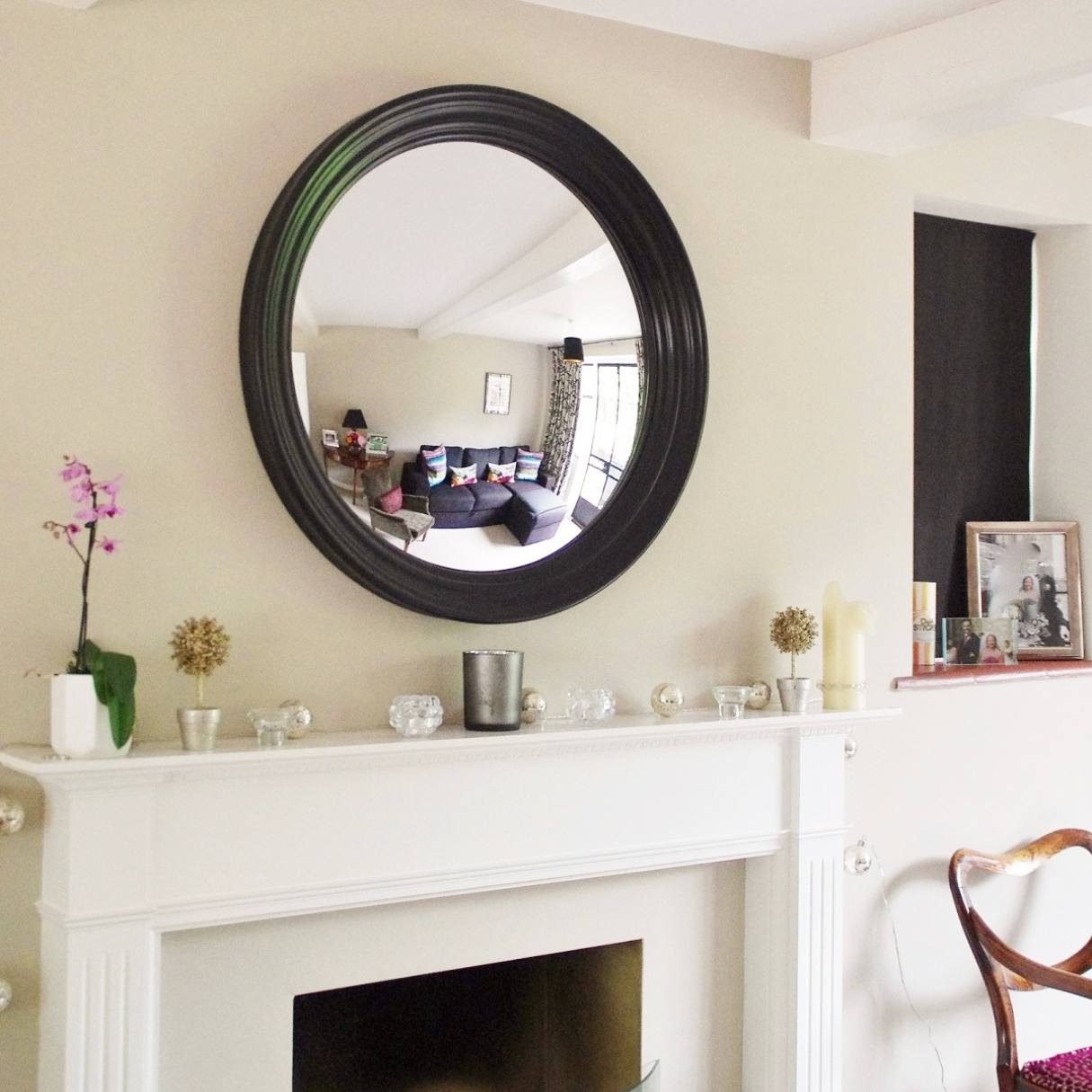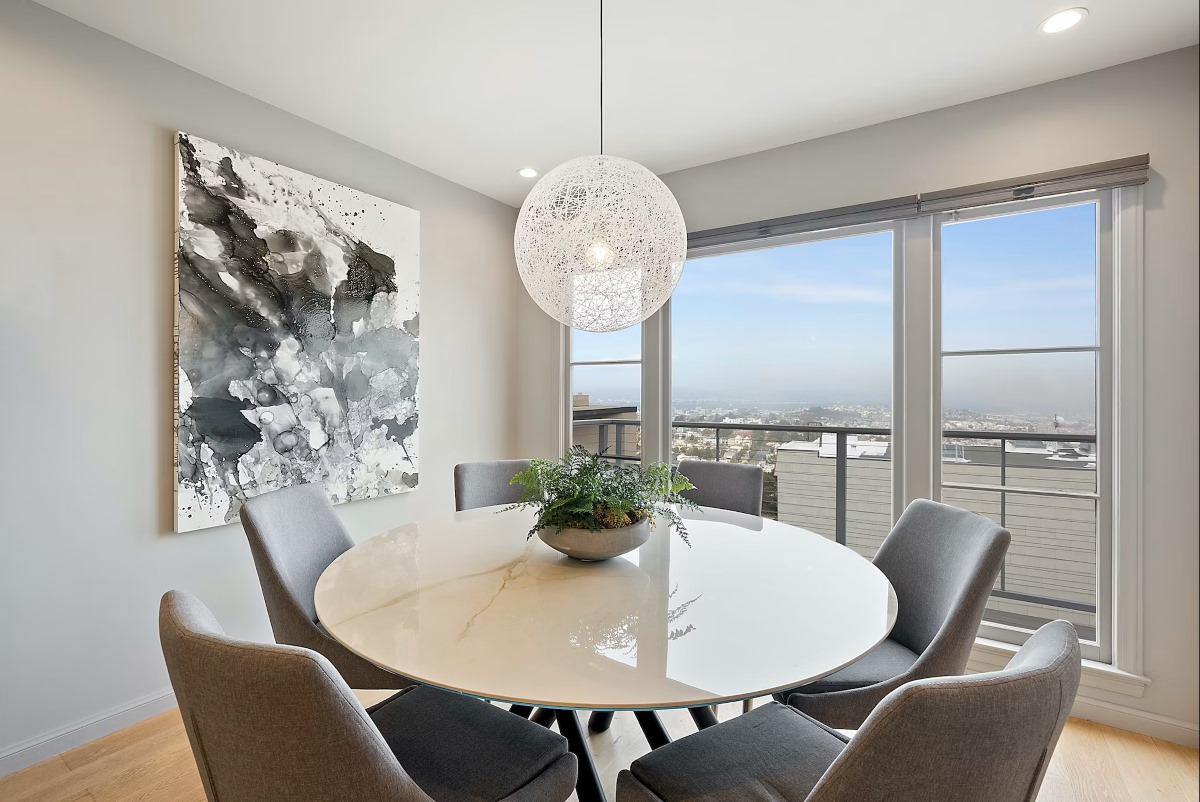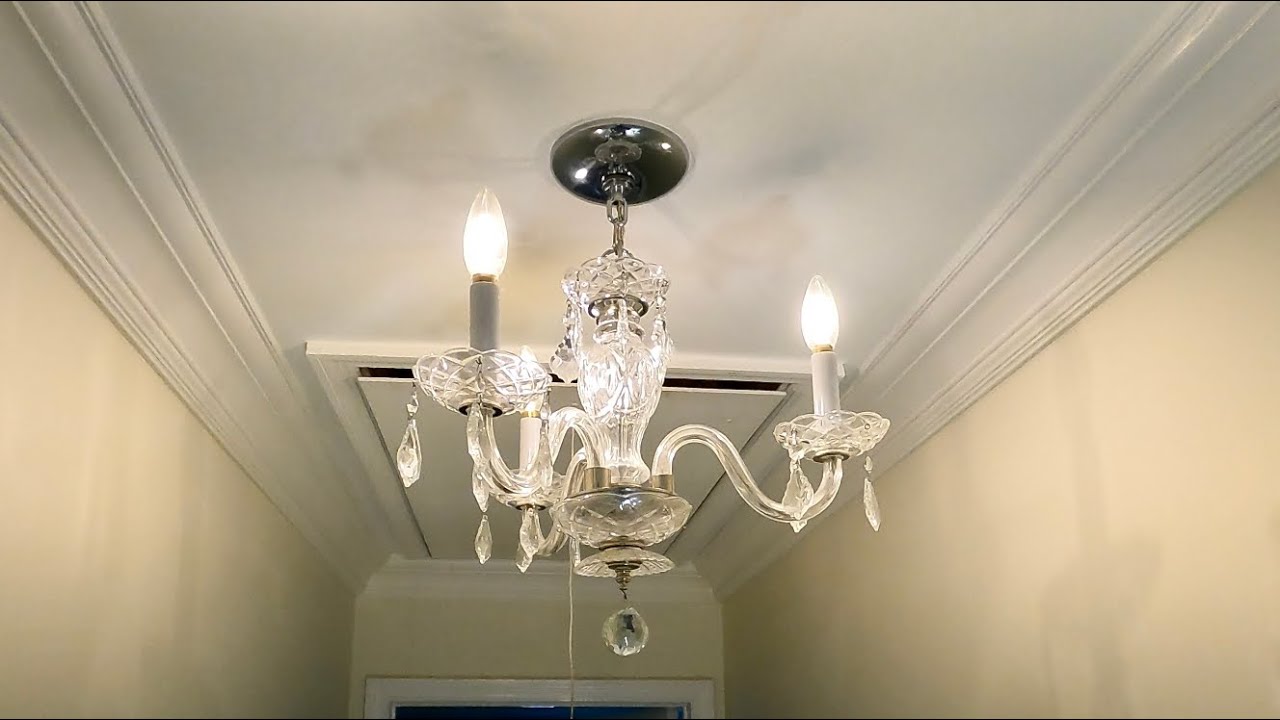Home>Articles>What Height Should A Dining Room Chandelier Hang


Articles
What Height Should A Dining Room Chandelier Hang
Modified: January 19, 2024
Discover the ideal height for hanging a dining room chandelier and get expert tips on chandelier placement. Read our informative articles to ensure the perfect lighting for your dining space.
(Many of the links in this article redirect to a specific reviewed product. Your purchase of these products through affiliate links helps to generate commission for Storables.com, at no extra cost. Learn more)
Introduction
A dining room chandelier serves as a centerpiece, adding style, elegance, and illumination to the space. However, determining the optimal height at which to hang a chandelier can be a daunting task. The height of the chandelier can greatly affect the overall aesthetics and functionality of the dining area. By considering various factors, you can ensure that the chandelier is positioned at the perfect height, creating a visually pleasing and functional space.
Key Takeaways:
- Properly positioning a dining room chandelier involves considering ceiling height, table size, chandelier design, and the comfort of diners. This ensures a visually balanced and functional dining space.
- Accurate measurements and adjustments are crucial for hanging a dining room chandelier at the optimal height, creating a harmonious and inviting atmosphere for enjoyable dining experiences.
Factors to consider when determining the height of a dining room chandelier
Several factors come into play when determining the appropriate height for a dining room chandelier. Let’s take a closer look at each of these factors:
Ceiling height
The height of your ceiling is one of the primary factors to consider when hanging a chandelier. For higher ceilings, you have more flexibility in terms of hanging the chandelier at a greater distance from the table. On the other hand, lower ceilings may require the chandelier to be positioned closer to the tabletop to avoid overwhelming the space.
Table shape and size
The shape and size of your dining table also play a crucial role in determining the height of the chandelier. For rectangular or oval tables, the chandelier should be centered within the table, with enough clearance on all sides. For round tables, the chandelier should be centered both horizontally and vertically.
Style and design of the chandelier
The style and design of the chandelier can influence the height at which it should be hung. Some chandeliers are designed to create a dramatic impact and may require a higher placement to fully showcase their beauty. Conversely, simpler and more understated chandeliers can be positioned at a lower height without compromising their elegance.
Read more: What Size Chandelier For A Dining Room
Height of the people using the dining table
Consider the average height of the people who will be using the dining table. You want to ensure that the chandelier is hung high enough to provide ample head clearance for everyone sitting at the table. This will prevent any accidental bumps or discomfort when dining beneath the chandelier.
Ceiling height
The ceiling height of your dining room is a crucial factor to consider when determining the height at which to hang your chandelier. The height of the ceiling will determine the overall visual impact of the chandelier and how it interacts with the rest of the space.
If you have a high ceiling, you have more flexibility when it comes to hanging your chandelier. A chandelier hanging too low in a high-ceilinged room can create an overwhelming and cramped feel. In this case, consider hanging the chandelier at a higher distance from the table to create a more balanced and harmonious look. This will also allow the chandelier to be the focal point of the room, drawing attention upwards and adding a touch of grandeur.
On the other hand, if you have a lower ceiling, it’s important to adjust the height of the chandelier accordingly. Hanging it too low can make the space feel cramped and visually disproportionate. Ideally, there should be sufficient distance between the chandelier and the tabletop to allow for comfortable seating and movement. This will create an open and inviting atmosphere, ensuring that the chandelier becomes an attractive feature without overpowering the room.
It’s worth noting that when dealing with exceptionally tall ceilings, you may opt for multiple chandeliers instead of a single fixture. This not only adds visual interest but also provides sufficient lighting throughout the entire dining area.
In summary, consider the height of your ceiling when determining the height of your dining room chandelier. A high ceiling gives you more freedom to hang the chandelier at a greater distance, while a lower ceiling requires a more balanced placement. By making the right adjustments, you can create a visually appealing and functional dining space that perfectly showcases your chandelier.
Table shape and size
The shape and size of your dining table play a crucial role in determining the height at which your chandelier should hang. Properly positioning the chandelier in relation to the table ensures a visually balanced and functional dining area.
For rectangular or oval tables, the chandelier should be centered within the table. It should hang in such a way that there is enough clearance on all sides. If the chandelier is too close to the edges of the table, it can create an uneven and cramped appearance. Conversely, if it hangs too far away from the table, it may feel disconnected from the dining area.
When it comes to round tables, the center of the chandelier should align both horizontally and vertically with the center of the table. This creates a symmetrical and visually pleasing arrangement. Pay attention to the diameter of the table as well – if it is particularly large, consider using a larger and more substantial chandelier to maintain the overall balance of the space.
Another consideration is the size of the chandelier relative to the table. As a general guideline, the diameter of the chandelier should be about half to two-thirds the width of the table. This ensures that the proportion of the chandelier to the table is visually appealing and harmonious.
Keep in mind that the height of the chandelier should be adjusted to provide sufficient clearance above the table surface. A good rule of thumb is to leave about 30 to 36 inches of space between the bottom of the chandelier and the tabletop. This allows for comfortable and unobstructed sightlines across the table while providing a sense of intimacy and elegance.
In summary, consider the shape and size of your dining table when determining the appropriate height for your chandelier. Centering the chandelier within the table and considering its proportion to the table’s width ensures a visually balanced arrangement. Additionally, maintain proper clearance between the chandelier and the table for comfortable and unobstructed dining experiences.
Style and design of the chandelier
The style and design of your chandelier can greatly impact the height at which it should be hung in your dining room. The right positioning will not only enhance the overall aesthetic appeal but also ensure that the chandelier complements the existing decor seamlessly.
If your chandelier features a grand and intricate design, it may require a higher placement to fully showcase its beauty. Hanging it too low can diminish its visual impact and make the space feel overcrowded. A higher placement allows the chandelier to become a captivating focal point, drawing the eye upwards and creating a sense of elegance and grandeur.
On the other hand, if your chandelier has a simpler and more understated design, it can be hung at a lower height without compromising its elegance. This allows for a more intimate and cozy ambiance while still adding a touch of sophistication to the dining area. A lower-hanging chandelier can also create a more inviting atmosphere, especially for more informal gatherings.
Consider the overall style of your dining room when deciding on the height of the chandelier. For traditional or formal settings, a higher placement can complement the classic decor and create a sense of luxury. In contrast, modern or contemporary dining rooms may benefit from a lower-hanging chandelier to maintain a clean and minimalist aesthetic.
Furthermore, take into account the physical dimensions of the chandelier. If it is particularly large or has long decorative elements, make sure to position it high enough to prevent any potential clashes with people’s heads or obstructions with the surrounding furniture.
Ultimately, the style and design of your chandelier should guide the height at which it is hung. Whether it’s a striking statement piece or a subtle and chic fixture, finding the perfect balance and positioning will enhance the overall ambiance of your dining space.
Height of the people using the dining table
Considering the average height of the people who will be using the dining table is an often overlooked but important factor when determining the height of the chandelier. You want to ensure that the chandelier is hung high enough to provide ample head clearance for everyone sitting at the table.
If you have taller individuals or those who prefer to sit upright and have a larger range of motion, it’s important to take their height into account. Hanging the chandelier too low may result in it obstructing their line of sight or causing accidental bumps or discomfort while dining beneath it. Nobody wants to feel cramped or constantly worry about hitting their head on the chandelier.
On the other hand, if you have shorter individuals or those who prefer a more intimate and cozy atmosphere, you can consider hanging the chandelier at a lower height. This can create a more intimate and inviting ambiance, especially for smaller gatherings or casual dining experiences.
In general, a good rule of thumb is to leave around 30 to 36 inches of space between the bottom of the chandelier and the tabletop. This provides sufficient head clearance for most individuals while maintaining a visual balance and proportion in the room.
General guidelines for hanging a dining room chandelier
To ensure the proper height and placement of your dining room chandelier, here are some general guidelines to follow:
Measurement techniques
Use a measuring tape or ruler to determine the distance between the ceiling and the top of the dining table. Take into account any fixtures or obstructions on the ceiling that may affect the hanging height of the chandelier.
Proper distance between chandelier and table
As mentioned earlier, leave about 30 to 36 inches of space between the bottom of the chandelier and the tabletop. This allows for comfortable seating and unobstructed sightlines across the table.
Read more: What Size Should A Dining Room Rug Be
Adjusting the height for different ceiling heights
If you have a high ceiling, hang the chandelier higher to create a balanced look and prevent it from overwhelming the space. For lower ceilings, adjust the height accordingly to maintain proportion and avoid a cramped feel.
By following these general guidelines, you can ensure that your dining room chandelier is hung at an optimal height, taking into consideration the height of the people using the table. This will create a visually pleasing and functional dining space where everyone can enjoy their meals comfortably.
Measurement techniques
Accurate measurements are essential when hanging a dining room chandelier to ensure proper placement and height. Here are some measurement techniques to help you obtain the precise measurements needed:
1. Measure the ceiling height
Begin by measuring the height of the dining room ceiling. Use a measuring tape to determine the distance from the floor to the ceiling. This measurement will serve as a reference point for determining the appropriate height for the chandelier.
2. Measure the dining table
Next, measure the length and width of the dining table. This will help you determine the proper size and proportion of the chandelier to the table. Measure the widest point of the table, whether it is rectangular, oval, or round, to ensure an accurate representation of its size.
Read more: How High To Hang Chandelier In Living Room
3. Determine the hanging height
Consider the general guidelines for the hanging height of the chandelier, which typically recommend leaving around 30 to 36 inches of space between the bottom of the chandelier and the tabletop. Use this measurement as a starting point to determine the hanging height more precisely by factoring in the ceiling height and the desired visual impact.
4. Mock installation
To visualize how the chandelier will look and assess if the height is appropriate, consider doing a mock installation. Use a hook or temporary hanging mechanism to suspend the chandelier at the estimated height. Step back and assess the overall appearance. Consider factors such as clearance above the table, proportion to the room, and how it interacts with other elements in the space.
5. Make adjustments
Based on your observations during the mock installation, make necessary adjustments to the hanging height. If the chandelier appears too high or too low, revise the height accordingly. Remember to take into account the factors discussed earlier, such as the ceiling height, table size, and style of the chandelier.
By utilizing these measurement techniques, you can ensure accurate placement and height of your dining room chandelier. Taking the time to measure carefully and make adjustments as needed will result in a beautifully balanced and visually appealing dining space.
Proper distance between chandelier and table
Ensuring the proper distance between the chandelier and the dining table is essential for both aesthetics and functionality. The right distance creates a visually appealing arrangement while providing sufficient illumination for the dining area. Here are some considerations for determining the proper distance:
1. Clearance for the table
Allow for enough clearance between the chandelier and the tabletop to prevent any obstructions or accidents while dining. A general guideline is to leave around 30 to 36 inches of space between the bottom of the chandelier and the tabletop. This provides ample head clearance and ensures comfortable seating.
2. Illumination needs
Consider the purpose of the chandelier – to provide adequate lighting for the dining space. The distance between the chandelier and the table should allow for uniform and sufficient illumination across the entire dining area. Adjust the height accordingly to ensure that the light is evenly distributed, preventing any shadows or dark spots on the table.
3. Proportion and visual balance
Take into account the size and shape of the dining table when determining the distance between the chandelier and the tabletop. The chandelier should be proportionate to the table, neither too small nor too large. A good rule of thumb is to select a chandelier with a diameter that is about half to two-thirds the width of the table for a visually balanced arrangement.
4. Style and design considerations
The style and design of the chandelier can influence the distance at which it should hang above the table. For more intricate and decorative chandeliers, consider leaving a slightly greater distance to fully showcase their beauty. Simpler and more understated designs can be positioned at a slightly closer distance, still allowing them to make an impact without overwhelming the space.
5. Adjusting the distance
Keep in mind that the proper distance may vary based on ceiling height and personal preferences. If you have high ceilings, you may need to adjust the distance slightly higher to maintain proportion and avoid overpowering the space. Likewise, if you have lower ceilings, adjustments may be needed to prevent the chandelier from seeming cramped or too close to the table.
By considering these factors and fine-tuning the distance, you can achieve an optimal placement for your dining room chandelier. The proper distance ensures both functionality and visual appeal, creating a harmonious and inviting dining atmosphere.
Adjusting the height for different ceiling heights
When hanging a chandelier in a dining room, it’s essential to consider the height of the ceiling. Different ceiling heights require adjustments to ensure that the chandelier is hung at the appropriate height. Here are some guidelines for adjusting the height based on the ceiling height:
1. High ceilings
If you have a high ceiling, you have more flexibility in hanging the chandelier at a greater distance from the table. This creates a visually balanced and proportionate look. Consider suspending the chandelier higher to accentuate the vertical space and make a bold statement. However, be mindful not to hang it too high, as it may appear disconnected from the dining area.
2. Low ceilings
For lower ceilings, you’ll need to adjust the height of the chandelier accordingly. Hanging it too low may make the space feel cramped and visually disproportionate. Aim to position the chandelier at a height that provides sufficient clearance above the table while maintaining a proportional look within the room. Be cautious not to hang it too close to the tabletop, as it may obstruct sightlines or create an uncomfortable dining experience.
Read more: Where Should Dining Room Be Located
3. Sloped ceilings
If your dining room has a sloped or vaulted ceiling, additional considerations are necessary. Ensure that the chandelier is installed in a manner that maintains its balance and remains in the center of the dining table. You may need to use an adjustable chain or rod to accommodate the slope of the ceiling while keeping the chandelier at the desired height.
Common mistakes to avoid when hanging a chandelier in a dining room
While hanging a chandelier in a dining room, it’s important to avoid common mistakes that can undermine the overall appearance and functionality. Here are some common pitfalls to be mindful of:
1. Hanging the chandelier too low
Hanging the chandelier too low can obstruct sightlines, create a cramped atmosphere, and increase the risk of accidental bumps. Be sure to leave adequate clearance above the table to ensure comfortable seating and movement.
2. Choosing the wrong size chandelier
Choosing a chandelier that is either too small or too large for the dining table can disrupt the visual balance of the space. Consider the size and shape of the table, as well as the overall dimensions of the room, when selecting a chandelier.
Read more: How Big Should A Dining Room Be?
3. Neglecting proper illumination
While aesthetics are important, don’t overlook the practical aspect of illumination. Ensure that the chandelier provides sufficient light for the dining area, without creating shadows or uneven lighting on the table.
4. Failing to consider the style and design
Each dining room has its own style and ambiance. Take into account the decor and overall theme when selecting a chandelier. Ensure that it complements the style and enhances the visual appeal of the space.
Conclusion
Hanging a chandelier in a dining room requires careful consideration of various factors, including ceiling height, table size, style, and the comfort of the people using the space. By adjusting the height for different ceiling heights and avoiding common mistakes, you can achieve a visually appealing and functional arrangement. A well-positioned chandelier enhances the overall aesthetic, illuminates the dining table, and creates a captivating focal point in the room. With the right approach, your dining room chandelier will add a touch of elegance and ambiance to your dining experience.
Frequently Asked Questions about What Height Should A Dining Room Chandelier Hang
Was this page helpful?
At Storables.com, we guarantee accurate and reliable information. Our content, validated by Expert Board Contributors, is crafted following stringent Editorial Policies. We're committed to providing you with well-researched, expert-backed insights for all your informational needs.








0 thoughts on “What Height Should A Dining Room Chandelier Hang”